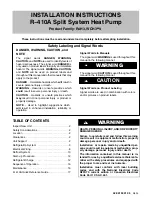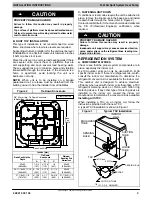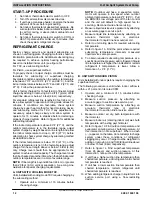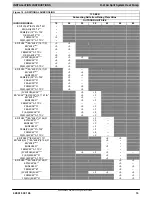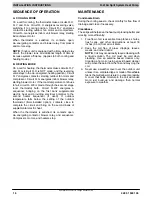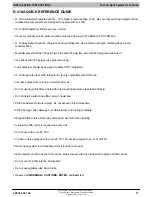
INSTALLATION INSTRUCTIONS
R
−
410A Split System Heat Pump
428 01 5301 05
13
Specifications subject to change without notice.
11. If outdoor air temperature or pressure at suction
valve changes, charge to new suction line
temperature indicated on chart.
12. Optimum performance will be achieved when
the operating charge produces 5
_
to 6
_
F
suction superheat at suction service valve
with 82
_
F (28
_
C) outdoor ambient and 80
_
F
(27
_
C) dry bulb (67
_
F / 19
_
C) wet bulb) indoor
temperature (DOE “B” test conditions) at rated
airflow.
C. HEATING MODE
To check system operation during heating cycle, refer to
the Tech Label on outdoor unit. This chart indicates
whether a correct relationship exists between system
operating pressure and air temperature entering indoor
and outdoor units. If pressure and temperature do not
match on chart, system refrigerant charge may not be
correct. Do not use chart to adjust refrigerant charge.
NOTE:
When charging is necessary during heating
season, charge must be weighed in accordance with unit
rating plate
0.6 ounces per foot of
a
inch liquid line above
or below 15 feet respectively (
17g per 305mm of 10mm
liquid line above or below 4.6m respectively).
Figure 13
SUPERHEAT CHARGING TABLE ˚F
SUPERHEAT CHARGING TABLE ˚C
EVAPORATOR ENTEREING AIR ˚F AT WB
EVAPORATOR ENTEREING AIR ˚C AT WB
˚F
50 52 54 56 58 60 62 64 66 68 70 72 74 76
˚C
10 11 12 13 14 16 17 18 19 20 21 22 23 24
Outdoor
Temp
SUPERHEAT ˚F AT LOWSIDE SERVICE PORT
Outdoor
Temp
SUPERHEAT ˚C AT LOWSIDE SERVICE PORT
55
9 12 14 17 20 23 26 29 32 35 37 40 42 45
13
5 7 8 9 11 13 14 16 18 19 21 22 23 25
60
7 10 12 15 18 21 24 27 30 33 35 38 40 43
16
4 6 7 8 10 12 13 15 17 18 19 21 22 24
65
6 10 13 16 19 21 24 27 30 33 36 38 41
18
3 6 7 9 11 12 13 15 17 18 20 21 23
70
7 10 13 16 19 21 24 27 30 33 36 39
21
4 6 7 9 11 12 13 15 17 18 20 22
75
6 9 12 15 18 21 24 28 31 34 37
24
3 5 7 8 10 12 13 16 17 19 21
80
5 8 12 15 18 21 25 28 31 35
27
3 4 7 8 10 12 14 16 17 19
85
8 11 15 19 22 26 30 33
29
4 6 8 11 12 14 17 18
90
5 9 13 16 20 24 27 31
32
3 5 7 9 11 13 15 17
95
6 10 14 18 22 25 29
35
3 6 8 10 12 14 16
100
8 12 15 20 23 27
38
4 7 8 11 13 15
105
5 9 13 17 22 26
41
3 5 7 9 12 14
110
6 11 15 20 25
43
3 6 8 11 14
115
8 14 18 23
46
4 8 10 13
*Optimum performance point, 82°F (28°C) outdoor ambient and (80°F / 27°C dry bulb), (67°F / 19°C wet bulb) indoor conditions. (DOE B Test
Conditions)
Where a dash (-) appears do not attempt to charge system under these conditions or refrigerant slugging may occur. Charge must be
weighed in.
Note
: Superheat °F is at low-side service port, Allow a tolerance of ± 3°F (± 1.7°C)
Note
: Indoor dry bulb between 70°F and 80°F (21°C and 27°C)
Figure
14
SUCTION PRESSURE AT SERVICE PORT PSIG
SUCTION PRESSURE AT SERVICE PORT kPA
SUPER-
HEAT
TEMP
˚F
108
112
117
121
126
131
139
141
146
SUPER-
HEAT
TEMP
˚C
743
774
805
836
869
902
957
971 1005
REQUIRED SUCTION TUBE TEMPERATURE
˚F
(MEASURED AT LOW-SIDE SERVICE PORT)
REQUIRED SUCTION TUBE TEMPERATURE
˚C
(MEASURED AT LOW-SIDE SERVICE PORT)
0
35
37
39
41
43
45
47
49
51
0
2
3
4
5
6
7
8
9
11
2
37
39
41
43
45
47
49
51
53
1
3
4
5
6
7
8
9
11
12
4
39
41
43
45
47
49
51
53
55
2
4
5
6
7
8
9
11
12
13
6
41
43
45
47
49
51
53
55
57
3
5
6
7
8
9
11
12
13
14
8
43
45
47
49
51
53
55
57
59
4
6
7
8
9
11
12
13
14
15
10
45
47
49
51
53
55
57
59
61
6
7
8
9
11
12
13
14
15
16
12
47
49
51
53
55
57
59
61
63
7
8
9
11
12
13
14
15
16
17
14
49
51
53
55
57
59
61
63
65
8
9
11
12
13
14
15
16
17
18
16
51
53
55
57
59
61
63
65
67
9
11
12
13
14
15
16
17
18
19
18
53
55
57
59
61
63
65
67
69
10
12
13
14
15
16
17
18
19
21
20
55
57
59
61
63
65
67
69
71
11
13
14
15
16
17
18
19
21
22
22
57
59
61
63
65
67
69
71
73
12
14
15
16
17
18
19
21
22
23
24
59
61
63
65
67
69
71
73
75
13
15
16
17
18
19
21
22
23
24
26
61
63
65
67
69
71
73
75
77
14
16
17
18
19
21
22
23
24
25
28
63
65
67
69
71
73
75
77
79
16
17
18
19
21
22
23
24
25
26
30
65
67
69
71
73
75
77
79
81
17
18
19
21
22
23
24
25
26
27

